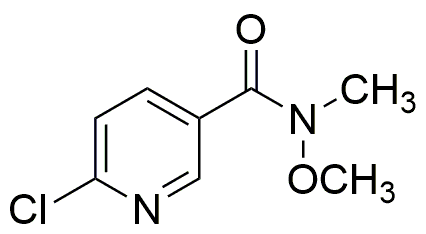6-Chloro-N-methoxy-N-methylnicotinamide is widely utilized in research focused on:
- Pharmaceutical Development: This compound serves as a valuable intermediate in the synthesis of various pharmaceuticals, particularly those targeting neurological disorders, enhancing drug efficacy and specificity.
- Agricultural Chemicals: It is used in formulating agrochemicals, providing effective solutions for pest control while minimizing environmental impact, making it suitable for sustainable farming practices.
- Biochemical Research: Researchers employ this compound in studies related to enzyme inhibition and metabolic pathways, aiding in the understanding of complex biological processes and disease mechanisms.
- Material Science: Its unique properties make it a candidate for developing advanced materials, such as polymers and coatings, which can offer improved durability and resistance to environmental factors.
- Cosmetic Formulations: The compound is also explored in cosmetic applications for its potential skin benefits, including anti-aging properties, appealing to the growing demand for effective skincare solutions.
Informations générales
Propriétés
Sécurité et réglementation
Applications
6-Chloro-N-methoxy-N-methylnicotinamide is widely utilized in research focused on:
- Pharmaceutical Development: This compound serves as a valuable intermediate in the synthesis of various pharmaceuticals, particularly those targeting neurological disorders, enhancing drug efficacy and specificity.
- Agricultural Chemicals: It is used in formulating agrochemicals, providing effective solutions for pest control while minimizing environmental impact, making it suitable for sustainable farming practices.
- Biochemical Research: Researchers employ this compound in studies related to enzyme inhibition and metabolic pathways, aiding in the understanding of complex biological processes and disease mechanisms.
- Material Science: Its unique properties make it a candidate for developing advanced materials, such as polymers and coatings, which can offer improved durability and resistance to environmental factors.
- Cosmetic Formulations: The compound is also explored in cosmetic applications for its potential skin benefits, including anti-aging properties, appealing to the growing demand for effective skincare solutions.
Documents
Fiches de données de sécurité (FDS)
La FDS fournit des informations de sécurité complètes sur la manipulation, le stockage et l’élimination du produit.
Spécifications du produit (PS)
Le PS fournit une description complète des propriétés du produit, notamment sa composition chimique, son état physique, sa pureté et les exigences de stockage. Il détaille également les plages de qualité acceptables et les applications prévues du produit.
Certificats d'analyse (COA)
Recherchez des certificats d'analyse (COA) en saisissant le numéro de lot du produit. Les numéros de lot et de lot se trouvent sur l'étiquette d'un produit, après les mots « Lot » ou « Lot de fabrication ».
Numéro de catalogue
Numéro de lot/série
Certificats d'origine (COO)
Ce certificat d'exploitation confirme le pays dans lequel le produit a été fabriqué, et détaille également les matériaux et composants utilisés et s'il est issu de sources naturelles, synthétiques ou autres sources spécifiques. Ce certificat peut être requis pour les douanes, le commerce et la conformité réglementaire.
Numéro de catalogue
Numéro de lot/série
Fiches de données de sécurité (FDS)
La FDS fournit des informations de sécurité complètes sur la manipulation, le stockage et l’élimination du produit.
DownloadSpécifications du produit (PS)
Le PS fournit une description complète des propriétés du produit, notamment sa composition chimique, son état physique, sa pureté et les exigences de stockage. Il détaille également les plages de qualité acceptables et les applications prévues du produit.
DownloadCertificats d'analyse (COA)
Recherchez des certificats d'analyse (COA) en saisissant le numéro de lot du produit. Les numéros de lot et de lot se trouvent sur l'étiquette d'un produit, après les mots « Lot » ou « Lot de fabrication ».
Numéro de catalogue
Numéro de lot/série
Certificats d'origine (COO)
Ce certificat d'exploitation confirme le pays dans lequel le produit a été fabriqué, et détaille également les matériaux et composants utilisés et s'il est issu de sources naturelles, synthétiques ou autres sources spécifiques. Ce certificat peut être requis pour les douanes, le commerce et la conformité réglementaire.


